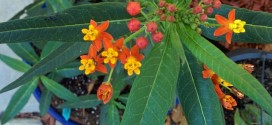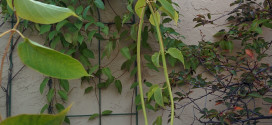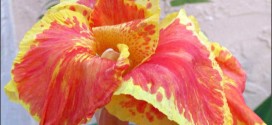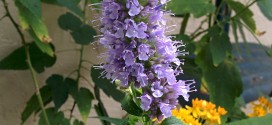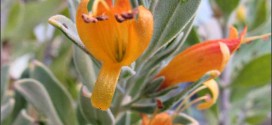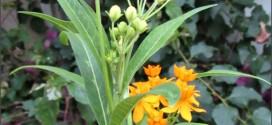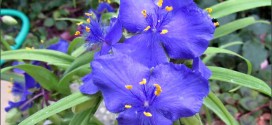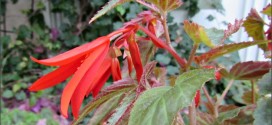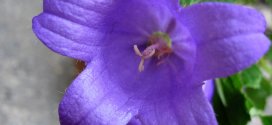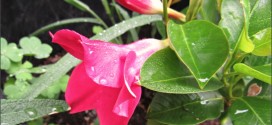Blood flowers (Aclepias curassavica) are red-orange with yellow hoods. Flowering continues throughout the summer to early autumn. Hummingbirds, butterflies and bees are attracted to the flowers. Monarch butterflies lay eggs on this plant and the resulting larvae (caterpillars) use the plant leaves as a food source. Flowers are followed by long, narrow seed pods (3-4” long) which split open when …
Read More »Flowers
Mystery vine seed pod
I thought this was a potato vine, but now I am not sure. Potato vines have dark fruit. This vine has white flowers in spring and summer. But the seed pod(s) are about twelve inches long and joined at the bottom. During the summer, I am distracted with other flowers and did not notice the growth pattern of the pods.
Read More »Canna Lily
The canna lily plant is a rhizomatous perennial with tropical-like foliage and large flowers that resemble that of iris. Canna lilies are low maintenance and easy to grow, and both their flowers and foliage offer long-lasting color in the garden. Flower color may be red, orange or yellow. Depending on the variety, foliage color varies from green to maroon, bronze, …
Read More »Agastache ‘Black Adder’
Okay. I bought this plant because of its name. There were no photos of the flowers; the plant was not yet in bloom. I just loved the 1980s BBC four-year series starring Rowan Atkinson (as Edmund Blackadder) and Tony Robinson (as Baldrick). When the plant finally bloomed last week, I was pleasantly surprised by its purple flower stalk. But, as …
Read More »Fuchsia – Emu Bush
Emu Bush is a great addition to a drought-tolerant garden in Sunnyvale. Emu Bush Fuchsias (genus Eremophila) are Australian shrubby native plants and there are over two hundred varieties known. The name Eremophila means ‘desert lover’ and derives from the Greek eremos (desert) and phileo (to love). The fruits are eaten by emus, which disperse the seeds in their droppings. …
Read More »Asclepias – Silky Mix
One of over two hundred varieties of Asclepias, ‘Silky Mix’ stands out for its beautiful alternating deep red and gold colored blooms. Blooming mid Summer through early Fall, ‘Silky’, like most Asclepias prefers sunny, dry locations and does well in substandard soil. A tender perennial in some zones and annual in others, ‘Silky Mix’ is a beautiful addition to any …
Read More »Tradescantia x andersoniana ‘Sweet Kate’
‘Sweet Kate’ is a compact, clump-forming, hybrid spiderwort that is noted for its unique yellow foliage. It typically grows to 12” tall. Three-petaled, purplish-blue flowers (to 1.5” diameter) accented by contrasting yellow stamens are borne in terminal clusters (umbels) atop stiff stems. Numerous flower buds form in each cluster, but individual flowers open up only a few at a time, …
Read More »Begonia boliviens s. ‘Santa Cruz Sunset’
The Santa Cruz Sunset begonia has dramatic angled petals. These plants fall into the tropical and subtropical category of perennials, growing well in U.S. Department of Agriculture plant hardiness zones 6 through 11. Many varieties with ornamental leaves and blossoms grow well outside in USDA zones 10 and 11, while hardy begonias survive winters in USDA zones 6 through 9 …
Read More »Bellflower
With their nodding heads, Campanula, or bellflower plants, are pretty perennial flowers. Bellflowers will bloom heaviest in June and July but can delight you with flowers all the way into October in some areas. The plant is native to many of the U.S. regions where cool nights and moderate temperatures prevail, creating ideal conditions for growing bellflowers. They require full …
Read More »Mandevilla vine
Among the garden’s most elegant vines, mandevilla offers stunning trumpet-shape flowers in shades of pink, white, or red. It’s the perfect plant for creating a lush, tropical look. Mandevilla is usually grown as an annual, though it can be overwintered indoors in a bright spot. Note: All parts of this plant are poisonous. First planted in 2014. I relocated the …
Read More »